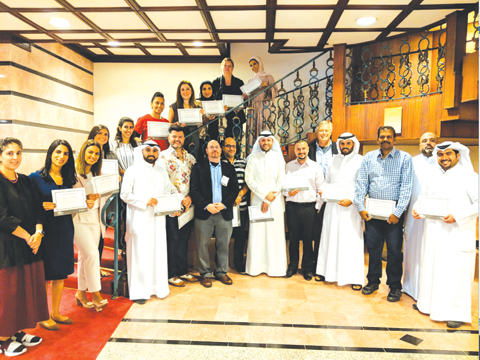Helping leaders develop understand and cultivate innovation and creativity
 KUWAIT: The participants of the KFAS/FourSight Creative Leadership course included bankers, journalists, media and HR professionals, engineers and scientists. The participants celebrated graduating the course with a group photo followed by lunch. — Photo courtesy of KFAS
KUWAIT: The participants of the KFAS/FourSight Creative Leadership course included bankers, journalists, media and HR professionals, engineers and scientists. The participants celebrated graduating the course with a group photo followed by lunch. — Photo courtesy of KFASKUWAIT: I recently had the opportunity to attend a course on creative leadership and innovative thinking. The course aimed to teach participants, mostly mid-level managers, how to leverage creativity to lead their organizations to greater levels of success and achievement. The course, organized by Kuwait Foundation for the Advancement of Sciences (KFAS) and delivered by FourSight, also helped leaders develop a 'language and approach to understanding and cultivating innovation and creativity' that they can then bring back to their organizations and businesses.
Creativity and innovation have become the holy grail of business in the digital age. The World Economic Forum, citing a survey conducted by IMG of 1,500 CEOs, named creativity as the "single most important skill for leaders."
Innovation = growth
In an economy like Kuwait's that has long been dependent on oil revenues for the bulk of earnings, creativity can be the spark that helps the private sector leapfrog to first place - or at least a greater share of the GDP. But to get there, all the various segments of the economy will need some 'creative' encouragement. This is where organizations like KFAS step in. Established in 1976, KFAS is a non-profit, non-governmental organization with the primary aim of driving progress in science and technology in Kuwait.
"We believe that by providing these types of training opportunities to everyone in the Kuwaiti private sector, we are giving them useful tools to not only improve their business, but to progress in their self-development," explains Sarah M Y Al-Abdullah, program officer at KFAS.
Innovation sustains growth and in Kuwait, the need for progress and especially creative progress in the fields of science and technology has never been keener. The entire globe has watched as digital and social media, fintech and other technology-oriented companies have disrupted traditional economic sectors and completely overwhelmed others. Companies like Google, Alibaba, Amazon, Instagram and other digital and technology companies are trailblazing a future where innovation and creativity aren't just a part of the game but a core aspect of the business model.
In Kuwait, tech companies like Talabat.com completely upended the restaurant delivery business and created an entire new market segment. Soon a whole slew of 'service-oriented' apps began popping up, taking on dry cleaning, salons, gyms and fitness and more. The more creative and innovative, the more space for an entrepreneur or even an established business to tap into or create a new market.
"In the Kuwait context, there is a real interest and desire for improving business practices and outcomes. The alignment with the objectives of KFAS to positively help the transformation of the economy to a modern and efficient, effective economy for all - these kinds of leadership practices help managers and leaders achieve those goals," notes Blair Miller, a partner of FourSight.
Tools and techniques
One of the tools taught to participants during the Creative Leadership workshop includes the idea of turning problems into questions. When faced with a problem - let's say no budget to transition a work system into an online digital platform - a creative leader can turn the problem into a question: What might be all the digital platforms, available for free or low cost, that could be utilized as substitutes suitable to our needs?
The idea seems simple but its power is in the effect. Rather than accepting a problem as a fact, the idea flips the problem into a question - a question with a possible or perhaps many possible solutions.
Other tools taught focusing on creative leadership by challenging the process, storyboarding and reversing assumptions. In an economy where businesses are often long established and resistant to change, simple brainstorming sessions may not be enough to break out of stagnancy.
"One of the takeaways is a basic awareness of their own creative leadership strengths and opportunities for development. We started on the first day by giving people insight into how they approach the creative process: Where they gain energy and where they lose energy. And throughout the course, we gave folks the experiences so they have tangible tools and tangible strategies for impacting their own leadership and those they work with, their teams, their colleagues and their peers," Russ Schoen, FourSight practitioner leader, explains.
The course, which ran for three days, is part of the KFAS Open Enrollment initiative which provides a range of professional development courses and workshops for Kuwait's private sector. "I learned many different tools and techniques for creative problem solving," said Hanadi Al-Hunaidi, district manager for Commercial Bank of Kuwait who attended the Creative Leadership course. "Ideas like 'reverse assumptions' help prompt creative and unique ideas that I can apply to my work."
Facilitators walked the group through a variety of activities to teach them through hands-on learning the techniques and tools of creative leadership. Examples of morale-boosting tactics like 'model the way' or 'enabling others to act' aren't just feel-good ideas but science-backed techniques for motivating teams to achieve their highest potential.
One of the most important tools, participants learned, is the leader's own attitude and openness to creativity. "Creative leadership is about people making the place - whether that's emerging or established organizations," notes Schoen. "The creative climate that the leader sets for his or her team has a direct influence on creative productivity."
By Jamie Etheridge










